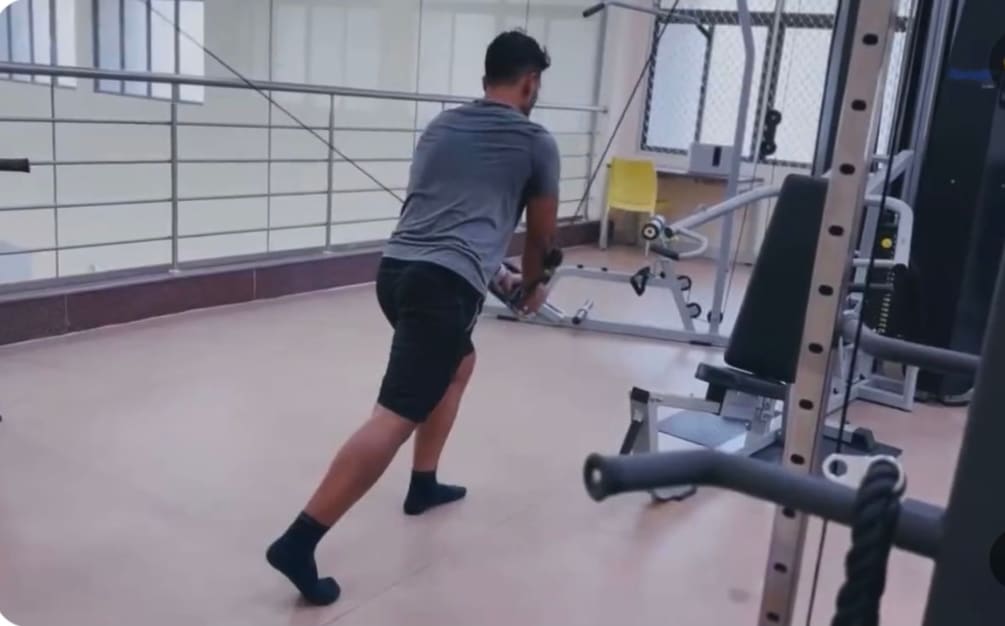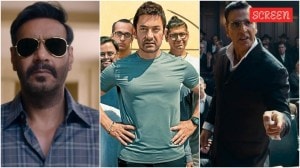How India’s four astronauts are preparing for Gaganyaan space flight
Given the intense gravitational force that astronauts experience on the flight, physical and mental fitness of the highest levels are essential requisites for the four astronauts training in Bengaluru, say experts
 Prime Minister Narendra Modi hands-over wings to astronauts-designate Shubanshu Shukla, Prashanth Balakrishnan Nair, Angad Prathap and Ajit Krishnan who have been selected to be the astronauts on India’s first crewed mission to space 'Gaganyaan Mission', at the Vikram Sarabhai Space Centre (VSSC). (Source: X/ @narendramodi)
Prime Minister Narendra Modi hands-over wings to astronauts-designate Shubanshu Shukla, Prashanth Balakrishnan Nair, Angad Prathap and Ajit Krishnan who have been selected to be the astronauts on India’s first crewed mission to space 'Gaganyaan Mission', at the Vikram Sarabhai Space Centre (VSSC). (Source: X/ @narendramodi)What does it take to be an astronaut? Someone with the physical and mental rigour of “super athletes”, say scientists tasked with keeping the four astronauts-designate primed for Gaganyaan, India’s maiden human spaceflight mission.
The four Indian Air Force (IAF) officers chosen for the mission – Group Captain Prasanth Balakrishnan Nair, Group Captain Ajit Krishnan, Group Captain Angad Pratap, and Wing Commander Shubhanshu Shukla – have been undergoing training at the Indian Space Research Organisation’s (ISRO) new astronaut facility in Bengaluru.
While astronauts, like fighter pilots, need sound knowledge of technical and technological aspects of a space mission — to handle the engineering and scientific challenges of flying to outer space — physical and mental fitness of the highest levels are essential requisites.
“They are under intense training — aerobic, anaerobic training and yoga. They are physically very fit. Mental maturity is a very important factor for an astronaut. Their health condition and fitness are way better than that of any of the super athletes in India now,” said an expert associated with the training process.
Medical evaluations of the astronauts are carried out every six months to assess if their physiological and mental health conditions are at optimum level. “Periodically there is evaluation and a lot of close monitoring,” said the expert.
While ISRO’s Human Space Flight Centre in Bengaluru is training the crew on simulators on the use of the systems in the crew module of the spaceflight, part of the physiological and psychological conditioning of the astronauts and all the medical evaluations are conducted by aerospace medicine experts at the Indian Air Force’s Institute of Aerospace Medicine (IAM) in Bengaluru. The IAM was also closely involved with the selection process of the Indian astronauts.
With the Indian space programme being a classified project of the IAF and ISRO, details of the physical and mental training regimen for the astronauts picked for the Gaganyaan mission, scheduled around 2025-26, are closely guarded.
However, over the last five years since PM Modi announced his plan in 2018 to speed up plans for an Indian human spaceflight — the project has been in the works since 2006 — bits of information on the physical and mental aspects of the training have emerged at science conferences and meetings.
Physical endurance is key
Speaking on the sidelines of an international space conference in Bengaluru in 2020, Oleg Valeriyevich Kotov, the Russian cosmonaut who was involved in the selection of the four IAF fighter pilots for Gaganyaan, had said, “They have to be very motivated, very strong, very healthy, with very high psychological resistance. They have to be open, communicative, very friendly, and smiling is always good.”
At a lecture at the Karnataka State Open University in July 2023, Gaganyaan Director R Hutton said that the four selected astronauts were “undergoing classroom, physiological and psychological training”.
 How space affects the human body
How space affects the human body
According to Hutton, the gravitational force that astronauts experience on the flight and in case of emergency situations requires a great deal of physical endurance with some situations warranting the handling of extreme gravitational force that’s equivalent to carrying a one-tonne Maruti car on one’s head.
“Physiology is important. When you are travelling to space there are inertia forces that will be acting on the body of the astronaut. One G is the gravitational pull of the earth. If the acceleration that you are going to face is 4G, then it is four times your body weight. If a person is 60 kg in weight, then they will encounter a force of 240 kg on the body. It is like carrying 240 kg on your head,” Dr Hutton said in the KSOU lecture last year.
“However, in a space flight if there is an abort, the kind of acceleration you are going to face will be around 12G to 16G — which is 16 times your body weight. If you are around 60 kg, then this is around one tonne of force on the body. The weight of a Maruti car is one tonne. It is like carrying a Maruti car on your head during space flight. This weight will be felt for a few seconds, not for minutes. But the astronaut has to be trained for these things,” he said, adding that the two crew members will be in space for three days, during which they will go to a distance of 400 km in space (from the surface of the Earth), inclined at an angle of 51 degrees.
The crew will be in a semi-supine position during the ascent and descent phase of the flight. This is meant to distribute the weight of gravitational pull to the whole body that would otherwise be felt on the spine.
In a paper published in 2022, Sqn Ldr Polash Sannigrahi, a bio-medical expert at the IAF’s Institute of Aerospace Medicine (IAM) in Bengaluru, which is tasked with keeping the astronauts in prime health, said, “The astronauts are exposed to a magnitude of stressors in the dynamic environment of space-flight. It requires them to live and work in an extreme environment that includes microgravity, radiation exposure, circadian dysrhythmia, reduced daily physical activity and closed air-water systems… Considering these changes and the demanding physical workload, a comprehensive physical fitness programme comprising physical exercises, swimming and yoga is formulated to produce a measurable training effect.”
Snow, water survival training in Moscow
It was the IAM which shortlisted the four astronaut candidates from a field of 60 IAF pilots who were considered for selection in 2019. The pilots, who were selected with the help of Russian experts, underwent the first part of their training at the Yuri Gagarin Cosmonaut Training Centre (GCTC) in Russia’s Star City.
In Russia, they were exposed to extreme conditions, including snow and water survival training, to prepare for the eventuality of a landing in such conditions.
“Specialists of the Center (GCTC) noted the highest level of motivation and skill of the Indian candidates. They did not get the most favourable weather conditions. It was raining, there was wet snow, an ice crust formed and melted underfoot. But even in this difficult situation, they completed all the tasks,” the GCTC said in a 2020 online report on the Indian astronauts.
 Astronauts doing mission-specific training, as part of which they familiarise themselves with the spacecraft and its operations ahead of the space mission, which is currently scheduled for next year.
Astronauts doing mission-specific training, as part of which they familiarise themselves with the spacecraft and its operations ahead of the space mission, which is currently scheduled for next year.
The physical assessment involved in IAM’s selection process of the astronauts involved eight activities — six of these involving athletics, including a 60-m sprint and a 5-km run, swimming 25 metres in 20 seconds and a continuous 200-metre swim.
The IAM has centrifuges – typically used to train and test fighter pilots – that are being used to help the astronauts build resistance for high gravitational forces during spaceflight. “They have a centrifuge with a capsule which will be moved around to achieve acceleration that will be felt on a space flight,” Dr R Hutton said.
Preparing for the long haul
While the astronauts have to be at peak levels physically, mental strength is an essential requisite. “Psychology is very important because there should be a certainty that no crash or fire will happen. When you are psychologically affected, then your normal senses will not work. You will not be able to put off a simple switch because your psychology has taken over,” Gaganyaan project director Dr Hutton said last year.
In preparation for the Indian human space flight program, IAM has received nearly Rs 10 crore for the enhancement of equipment and facilities at its centre in Bengaluru.
Since 1982, when the IAM was involved in the selection and basic training of Wg Cdr Rakesh Sharma and Air Commodore Ravish Malhotra for the 1984 Russian Soyuz T 11 mission – where Rakesh Sharma became the first Indian in space – the institute has been required to come up to speed for a more complex, intensive and time-consuming training for Gaganyaan.
One of the four selected Indian astronauts is also expected to undergo training in the US for a flight to the International Space Station under an Indo-US collaboration initiative.
“We try to evaluate the health status of individuals for space flights over a long period of time. We are looking at the health of a candidate and providing a prognosis for the next few years – five years or 10 years. We are not selecting candidates for just one short mission,” the Russian cosmonaut Oleg Kotov said in 2020 in Bengaluru.












